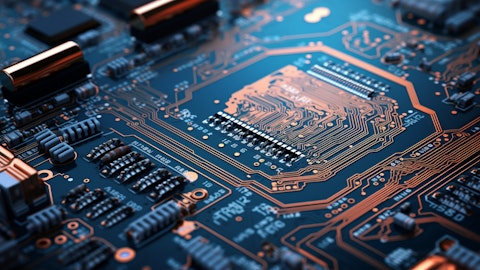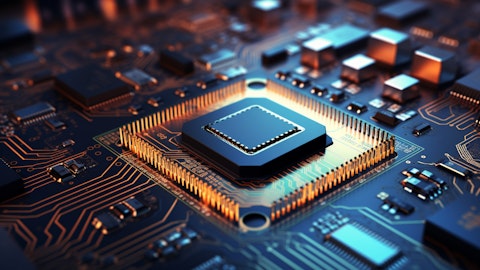Paul Treiber: That’s helpful to hear. The earlier comments on being comfortable with the customer concentration, is that — we’re not getting to a specific outlook for what you see in the customer concentration. Could you just give us a sense of why you’re comfortable with it at 34% this past quarter?
Rob Mionis: Yes, because it’s not a single program. It’s multiple programs across multiple technologies, crossing a decade, even over a decade of past relationships and with continued strong performance, not just on high value EMS, but across engineering engagements as well. So it’s a very sticky relationship, one backed by mutual respect and high performance. We never take these things for granted, but we’re happy with the breadth of solutions that we’re providing this customer.
Paul Treiber: And then just lastly, just on the capacity side of the equation, you mentioned that you do have capacity. Can you speak to your capacity utilization and how it compares to what you’ve historically averaged? And then are you seeing additional opportunities with your customers for co-investments in capacity expansion?
Rob Mionis: Yes, so capacity or utilization is extremely high in our Azure sites where the majority of our AI demand is fulfilled. Within our business, highly utilized sites and highly leveraged sites are very profitable sites, and that’s what you’re seeing in our results and we carefully manage our capacity. We have decided to invest in some additional capacity and we think those investments should take care of us for the next clip of time. We don’t foresee any need for any additional co-investments at this time. We think the expansions that we are underway should take care of us for a period of time and keep those high utilization rates.
Mandeep Chawla: Paul, just to add on to that, in November when we gave our Investor Day, we had provided a revenue outlook going up to 2026, the range was $9.5 billion to $10 billion. And we had stated at that time that we believe that we have the footprint now to fulfill that. So we don’t need to green field a brand new factory in a new country in order to keep up with that demand outlook. And so, one of the things that we’re pleased about is that, we believe we’re able to — while the CapEx may be a little bit elevated, more or less in line with our historical levels, while still being able to grow revenue.
Paul Treiber: Thanks for taking the question.
Mandeep Chawla: Thanks, Paul.
Operator: Thank you so much. [Operator Instructions] And your next question comes from the line of Todd Coupland of CIBC. Your line is now open.
Todd Coupland: Great. Thanks, and good morning, everyone. I wanted to ask specifically about compute. We’re seeing that decelerate into Q2 and into the second half of the year, what factors are you looking for in terms of reaccelerating that line? And give us any indication on when you think that might happen? Thanks a lot.
Rob Mionis: Yes. I’ll start. So compute in Q1 was up over a 130% year-over-year, compute in Q2 was up in the 70 percentage range on a year-over-year, I’d not call that within the first half of the year decelerating. As we go into the second half of the year, some of that is — at least our outlook is driven by a little bit of murkiness as we exit the year. But broadly speaking, compute volume and demand remains material constraint. So again, demand exceeds supply and as material availability becomes available that might give us an opportunity to increase our output. But this is a visibility that we have at this point in time.
Mandeep Chawla: Yes. And Todd, I would maybe just add to that to say, as we talked about when the demand cycle for hyperscalers started to really accelerate in the middle of last year is that, we believed it was going to start with compute and that it was going to start migrating over to AI type of networking which is 400G switches, but moving into 800G switches as well. And so, we’re starting to see that. Customers have a fixed level of capital and they choose on where they deploy that capital. And what we’re seeing right now is more of a shift towards the comp side. Because communications is a larger part of our portfolio, we think that we’re going to come out more ahead because of that. Not to say that compute is going away, because the other dynamic that we have to keep in mind is that, the comps now are becoming quite high. But overall, we are seeing healthy demand coming out of Q1 and going into Q2.
Todd Coupland: And if I could just follow up on that. Within compute, you’ve had this debate on merchant silicon versus custom silicon. And obviously, the hyperscalers are all coming up with their own custom processors. And that’s yet to come. I guess I would have thought that that might have started to flow into your business, and I’m just wondering if you could help bridge that gap of understanding? Thanks a lot.
Rob Mionis: Yes, Todd. We are definitely heavily tilted towards custom silicon versus merchant silicon. And we have been the benefactor of that switch. As you see from the announcements in the press, the hyperscalers are continuing to invest in custom silicon. And as these new custom silicon comes to market, we feel confident that we’ll be able to get access to them and also provide these types of solutions to our customers moving forward. So that trend is continuing, and I think we’re taking advantage of it.
Todd Coupland: Thanks for the color. Appreciate it.





